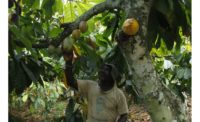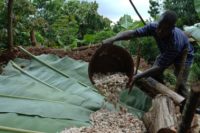Olam International has updated the Olam Farmer Information System (OFIS), giving 100,000 smallholder farmers access to detailed information about their farms.
Each farm has been mapped and surveyed with an Android app. The collected data offers tailored support to smallholders and more precise details to customers making critical choices about financial interventions, such as agri-training, school or healthcare infrastructure.
OFIS Director Simon Brayn-Smith emphasizes the platform’s capability in helping all participants in the supply chain.
“You have to remember that while big data usage is commonplace among large-scale farms, our field officers are working in some of the world’s most isolated places,” he says. “With the OFIS technology they have been able to survey and record, on the spot, thousands of farms, the surrounding landscape, as well as the farmer’s social circumstances. This gives the farmers, Olam and our customers greater insight to tackle issues from poor yields to climate change and child labor. And by ‘GeoTagging’ each bag of produce we can trace it from farm to fork, providing assurance to end users on product provenance.”
The OFIS platform has been designed to build capacity from the ground up and allows farmer groups and cooperatives to manage stock levels and keep an eye on creditor and debtor positions, the company says. It also gives them detailed reports about their business activities, including a way to prove provenance of a product, which in turn, helps them access traceability premiums.
As part of Olam’s sustainability interventions under the Olam Livelihood Charter, which supports 300,000 farmers, OFIS can now give personalized farm development plans to each farmer with advice on how to make the most of each plot and crop.
More than 10,000 customized plans have been generated for cocoa farmers. This advice, such as when and how to prune based on the exact age of the trees, can be texted straight to the farmer’s mobile phone. Having a plan empowers the farmer, while progress against recommendations can be tracked over time and adapted where necessary. They can also receive payments for their crops into a ‘mobile wallet,” allowing for the creation of credit histories for farmers.
In addition, Olam field staff and implementing partners can keep track of farmer training progress and program targets. Crosscutting and comparing extensive data sets enables staff to understand more easily why one farmer group, or even an individual farmer, may be getting lower yields than others in the same region. This enables more efficient use of resources, helping to achieve scale.
Currently OFIS is being rolled out across Olam’s cashew, cocoa, coffee, hazelnuts, palm, pepper, rice and rubber supply chains, with a goal to reach 500,000 farmers by 2020.





